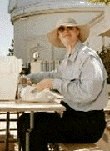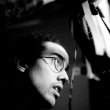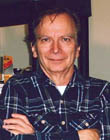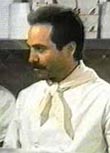|
|
 
|
|
Author
|
Topic: Deluxe Changeover Cue Marks Placement
|
John Pytlak
Film God

Posts: 9987
From: Rochester, NY 14650-1922
Registered: Jan 2000
|
 posted 12-20-2004 11:14 AM
posted 12-20-2004 11:14 AM





I posted this in the "Changeovers: Tips and Tricks" topic, but thought it merited its own topic:
I just heard that Deluxe Laboratories will be making a slight change to the placement of the cue marks on release prints as of January 2005. The location of the cue marks will now be as specified in standard SMPTE 301-1999:
quote:
6.2 Motor cue
The motor cue shall consist of black circles or clear
circles, printed from a negative which has had four
consecutive frames marked as shown in figures 6, 7,
and 8 for 16-mm, 35-mm, and 70-mm films, respectively.
The position and dimensions of this mark shall
be as given in table 1. Following the four frames
containing the motor cue, there shall be 172 frames
to the beginning of the changeover cue.
quote:
6.3 Changeover cue
The changeover cue shall consist of four frames
containing circles of the same dimensions and position
on the frame as those in the motor cue. Following
the four frames of the changeover cue, there shall be
18 frames to the beginning of the runout section of the
trailer.
In most cases, this will mean that the motor cue is 4 frames closer to the changeover cue, and the changeover cue is 6 frames closer to the black runout tail leader than previous practice, which had been based on the television leader standard (SMPTE 55-2000).
So, adjust your timing to make perfectly timed changeovers.
| IP: Logged
|
|
|
|
|
|
|
|
|
|
|
|
|
|
Scott Norwood
Film God

Posts: 8146
From: Boston, MA. USA (1774.21 miles northeast of Dallas)
Registered: Jun 99
|
 posted 12-20-2004 05:57 PM
posted 12-20-2004 05:57 PM





Does this change apply to Deluxe Hollywood, Deluxe Toronto, or both? If it means that Technicolor {Hollywood, New York, London, Rome} and Deluxe {Toronto, Hollywood} will now both use the same standard, I'd say it's a step in the right direction.
I'm still confused as to why there are two different standards for cues (three, if you count the bizarro way in which 16mm prints from Swank are cued). Why would TV prints require a similar but different standard from theatrical prints?
When adding cues to prints which arrive without them, I was taught to do this:
- tail -
24 frames of picture
4 frames of cues (changeover cue)
168 frames of picture
4 frames of cues (motor cue)
- rest of print -
- head -
Is this the TV standard?
I've also heard from one old-timey projectionist to do this:
- tail -
16 frames (1 foot) of picture
4 frames of cues
184 frames (11 feet) of picture
4 frames of cues
Was this ever a real standard or was this guy just confused?
Oh,and since Deluxe is suddenly so keen on following SMPTE standards, can we get them to start adding longer tail leaders to their prints? ![[Mad]](mad.gif)
| IP: Logged
|
|
|
|
|
|
|
|
Jeffry L. Johnson
Jedi Master Film Handler

Posts: 809
From: Cleveland, Ohio, USA
Registered: Apr 2000
|
 posted 12-22-2004 12:39 PM
posted 12-22-2004 12:39 PM





SMPTE-55 (SMPTE Universal Leader)
Motor Cue
4 frames
Distance between Cues
168 frames
Changeover Cue
4 frames
Distance to Last Frame
24 frames
TOTAL LENGTH
200 FRAMES
====================
ASA Z22.55 (Academy Leader) and SMPTE-301 (SMPTE Projection Leader)
Motor Cue
4 frames
Distance between Cues
172 frames
Changeover Cue
4 frames
Distance to Last Frame
18 frames
TOTAL LENGTH
198 FRAMES
====================
The dual standards (dueling?) were created in 1965 with the publication of the proposal for the SMPTE Universal Leader.
The television film industry quickly adopted the Universal Leader standard. The motion picture exhibition industry generally kept using the original "Academy" leader standard, adding new information as necessary.
Some laboratories adopted the Universal Leader and cue mark spacing. Others kept using the "Academy" leader and cue mark spacing. At least one laboratory kept using the "Academy" leader but converted to the SMPTE Universal Leader cue mark spacing.
The SMPTE Working Group on Leaders and Cue Marks (L6.38) Preliminary Report (1988 October) "confirmed that virtually all broadcast material is now distributed on tape", "that the parties affected by the leader are almost exclusively theatre, post-production and archival projectionists", and that "the changeover cues vary from one lab to another".
N. R. Olding, Subcommittee Chairman; "The SMPTE Universal Leader for Release Prints," Journal of the SMPTE, 74:34-35, 1965 January.
quote:
History
For many years the "Academy Leader" was in general use. In this leader the count-down was based on 16 frames of 1 foot of 35mm film, a holdover from the silent films in which the 16-frame spacing was equated in terms representing feet of film or seconds in running or projection time.
In 1950, the growing use of film in television production made it evident that some changes were highly desirable. An SMPTE Subcommittee under the chairmanship of C. L. Townsend was set up to revise the Academy Leader to fulfill the new requirements. This subcommittee, in cooperation with producers, laboratories, projectionists and broadcasters, developed a new All-Purpose Leader, commonly called the Society Leader; it was accepted for trial and has since served the industry. That Subcommittee considered 24-frame spacing for threading cues; but the change in spacing was dropped to avoid confusion.
Since 1951, private and commercial use of 16mm and the use of 35mm and 16mm film by television broadcasters has increased rapidly. In 1958, the requirement for 24-frame, 1-second, spacing of threading cues, to fit in with projection and TV cuing practices, was again brought to the attention of officers of the SMPTE and was passed by them to the Television Committee Chairman, W. T. Wintringham, for action.
quote:
Although it was not to become part of the leader, in order to standardize on the seconds basis, the spacing of the motor and changeover cues has been reduced from the present 172 frames to 168 frames or 7-sec running time. The Subcommittee had hoped to reduce the changeover cue to 5 sec but yielded to pleas for more time to permit older machines to reach stable operating speeds.
SMPTE 301, designed to be exclusively a motion picture projection leader, returned to the Academy Leader specifications for 16-frame units (film feet) and cue mark spacing.
| IP: Logged
|
|
|
|
|
|
|
|
All times are Central (GMT -6:00)
|
|
Powered by Infopop Corporation
UBB.classicTM
6.3.1.2
The Film-Tech Forums are designed for various members related to the cinema industry to express their opinions, viewpoints and testimonials on various products, services and events based upon speculation, personal knowledge and factual information through use, therefore all views represented here allow no liability upon the publishers of this web site and the owners of said views assume no liability for any ill will resulting from these postings. The posts made here are for educational as well as entertainment purposes and as such anyone viewing this portion of the website must accept these views as statements of the author of that opinion
and agrees to release the authors from any and all liability.
|

 Home
Home
 Products
Products
 Store
Store
 Forum
Forum
 Warehouse
Warehouse
 Contact Us
Contact Us




 Printer-friendly view of this topic
Printer-friendly view of this topic








![[Wink]](wink.gif)
![[Razz]](tongue.gif) But I see why they moved the first cue 4 frames closer: to lay the first frame of the first cue on the 11 ft. mark, instead of the last frame. And, closing up the 1-second timing on the last cue is because the MTV generation reacts faster.
But I see why they moved the first cue 4 frames closer: to lay the first frame of the first cue on the 11 ft. mark, instead of the last frame. And, closing up the 1-second timing on the last cue is because the MTV generation reacts faster.

![[Big Grin]](biggrin.gif)

![[Mad]](mad.gif)







